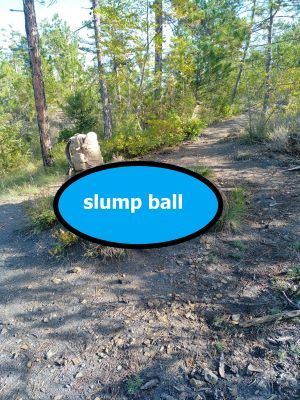Curiosité géologique, le "slump ball" a pour origine un glissement par gravité des couches sédimentaires subaquatiques.
Au départ, les sédiments se déposent en couches succéssives, formant des strates régulières. Si les dépots se produisent dans une pente, il peut arriver qu'une strate composée de sédiments mous glisse vers le bas, entrainant une déformation, des plissements ou une dislocation de la strate, alors que les strates inférieures et supérieures plus solidifiées, restent intactes.
Les "slump-balls" sont des fragments de strates enroulés sur eux-même, formant ainsi une boule.
Sur l'illustration suivante, nous pouvons voir un glissement qui s'est produit de la droite vers la gauche.

Après les mouvements tectoniques qui ont remené ces couches sous marines à la surface, l'action de l'érosion a mis à jour progressivement les strates.
Sur la commune du Brusquet entourée par les terres noires, roches tendres soumises à une forte érosion, le décapage des strates dévoile quelques exemplaires de slump ball, roches plus solides que leur environnement initial.

Aux coordonnées de la page, vous trouverez un panneau mettant en avant la géologie du site autour de vous.
Pour valider votre passage sur la earth-cache, répondez aux questions suivantes:
Question 1: Observez un slump ball et décrire son aspect: roche homogène ou hétérogène? La couleur et consistance est t-elle uniforme ou variée?
Question 2: Observez l'environnement sur lequel reposent les slump ball. Quelles différences voyez vous entre les deux?
Question 3: Pour attester de votre passage, prenez une photo de vous, de votre GPS ou autre, devant le panneau descriptif des slump ball.
Loguez cette cache "Found it" sans publier de photo du slump ball, et envoyez-moi vos propositions de réponses soit via mon profil, soit via la messagerie geocaching.com (Message Center), et je vous contacterai en cas de problème.
Les explications sur la formation des slump ball ont été trouvées sur le site internet geo-alp.com

A geological curiosity, the "slump ball" originates from a sliding by gravity of the underwater sedimentary layers.
Initially, the sediments are deposited in successive layers, forming regular strata. If the deposits occur on a slope, it can happen that a stratum composed of soft sediments slides down, causing deformation, folding or dislocation of the stratum, while the lower and upper strata which are more solidified, remain intact .
The "slump-balls" are fragments of strata rolled up on themselves, thus forming a ball.
In the following illustration, we can see a shift that has occurred from right to left.

After the tectonic movements that brought these submarine layers to the surface, the action of erosion gradually updated the strata. In the commune of Brusquet surrounded by black earth, soft rocks subject to strong erosion, the stripping of the strata reveals some examples of slump ball, rocks more solid than their initial environment.

At the coordinates of the page, you will find a panel highlighting the geology of the site around you.
To validate your passage on the earth-cache, answer the following questions:
Question 1: Observe a slump ball and describe its appearance: homogeneous or heterogeneous rock? Is the color and consistency uniform or varied?
Question 2: Observe the environment on which the slump balls rest. What differences do you see between the two?
Question 3: To certify your passage, take a photo of yourself, with your GPS or other, in front of the descriptive panel of the slump balls.
Log this "Found it" cache without publishing a photo of the slump ball, and send me your suggested answers either via my profile or via geocaching.com messaging (Message Center), and I will contact you if there is a problem.
Explanations on the formation of slump balls were found on the website geo-alp.com